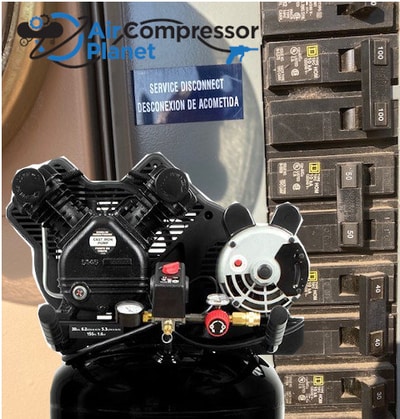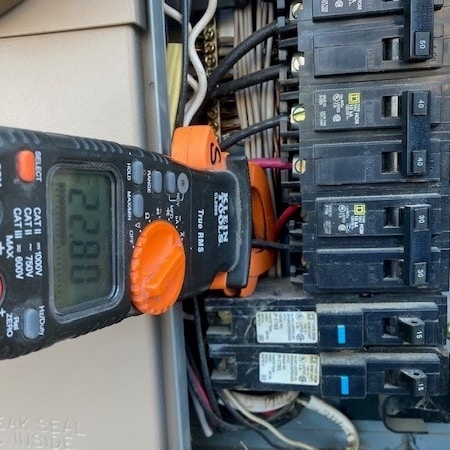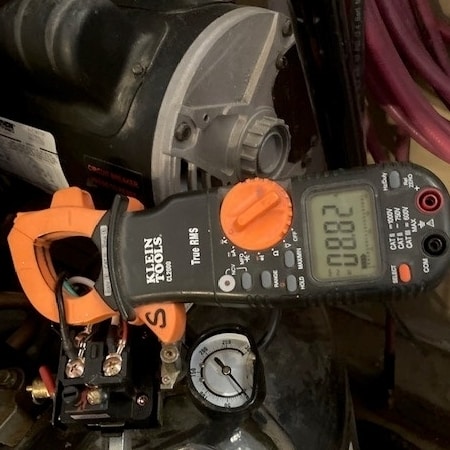There are two reasons an air compressor can trip a breaker,
electrical and mechanical.
Most commonly, the motor is pulling too much amperage but before diving into the electrical circuit. Inspect for mechanical issues, such as the pump being stiff or locked up. Inspect bleeder or loader valve. I run into this occasionally, I hate myself when I spend two hours testing circuits, and it should have been a fifteen-minute job replacing a bleed-off valve.
Safety first: safety glasses unplug the compressor.
Visually inspect the compressor and surrounding area for obstructions to the mechanical parts of the compressor, such as pulleys, belts, pump, and the motor.
Before You Can Repair Your Breaker concern, let us save you some time by asking a few qualifying questions.
This is the first time plugging in this compressor, and the breaker tripped while running?
a) my compressor is new
b) my compressor is not new
my new air compressor trips breaker
The most common reason I find circuit breakers tripping with new compressors is too much load from combined amperage draw from multiple devices and tools on one circuit.
Sometimes on new compressors, the easiest way to cure this concern would be to move the compressor to a dedicated circuit large enough to handle the load. Moving the compressor may also identify a week breaker. If the breaker trips on one 15 amp breaker but not the other, The tripped one may be old and worn.
I would recommend replacing that worn breaker and move the compressor back to its original location.
STILL, TRIPPING BREAKER?
Your air compressor is tripping the breaker due to untenable current demands that exceed the breaker’s capacity. Several factors can cause your compressor to pull too much power, but we will not waste time testing the compressor. If we determine it is the compressor, It’s new; bring it back.
Before resetting the breaker, find the amp rating on the compressor, be sure that the breaker is large enough to handle all the appliances and tools on that circuit. Take this time to unplug all other devices or tools that may be causing a draw on that circuit.
Inspect the outlet that the compressor is now using. Is it lose, or has any signs of overheating? Replace the outlet or repair before going on to the next step.
How to test an unloader valve on an air compressor
To see if a failed unloader valve is the root of the problem, take the following steps:
- Unplug your air compressor
- Open the tank drain and let all pressurized air escape out of the tank
- Plug the air compressor back in
- Turn the air compressor switch to “ON,” restarting your air compressor. If the compressor starts, let the system fill.
- if the compressor still will not start inspect the pump.
- Once the compressor turns off, bleed some air until the motor starts. Replace the valve if the breaker trips while attempting to turn on with a full tank. The cause was the valve not releasing pressure from the cylinder head.
Inspecting an air compressors pump for mechanical concerns
To see if a failed pump is the root of the problem, take the following steps:
- unplug the compressor
- remove the cover plate or belt guard
- turn the pump by hand it should spin freely
If the pump is locked or hard to turn, It time to replace the pump
If the pump turns freely its time to test the electrical circuit.
Disclaimer: Self-diagnosing air compressor concerns may not be a simple problem. If you are not familiar with electric motors or circuitry, then you may need to take your air compressor into a shop to have a load test performed and diagnosed. Performing electrical tests is hazardous and should only be performed by a professional.
Measuring the amps that your air compressor produces while in use can be done one of three ways at the breaker box, exposing the wires at the compressor or using a splitter between the outlet and the cord of the compressor.
Click the link below to skip you down the page that best fits your situation:
My compressor is:
How to Measure amperage on an air compressor. 110-volt A/C
Note: The compressor should be almost full of air to represent a heavier load on the motor on start and run.
plugging in a splitter into the outlet then plugging the compressor’s cord into the splitter is much like using an extension cord is the easiest way to test amperage.
————————-video————————————–
- measuring the amperage at the breaker box,
Safety glasses! Open the breaker box and turn off the main breaker,
reset the breaker to the compressor and then shut it off, remove the panel to expose the wires and breakers
place amp meter around the load wire, let some air out of the compressor so when you flip the breaker, the compressor turns on.
Watch the meter at start-up and while running.
Was the amperage on start-up and running lower than that of the manufacturer specifications?
2.measuring the amperage draw with an outlet splitter or inline wattage meter. If You have this splitter, it makes life a whole lot simpler. Unplug the air compressor, plug the splitter into the wall plug in the compressor to the splitter. Clip your meter on the splitter. You are ready to start the air compressor. measure the amps at start-up and while running
Was the amperage on start-up and running lower than that of the manufacturer specifications?
3.Measuring the amperage draw on the air compressor is my last option. The only reason I sometimes measure amperage this way is I suspect the capacitor, and a quick visual inspection may reveal it needs replacing. All air compressors are different, and the manufacturer uses as little wire as possible, making it sometimes challenging to expose and separate wires. Once you have gotten a location to clamp the meter. Start the compressor and watch the amps at start-up and while running.
Was the amperage on start-up and running lower than that of the manufacturer specifications?
How to measure amperage on an air compressor. 220-volt A/C
Safety first! Unplug or turn off the breaker, test to make sure power is off. Inspect all wire connections on the compressor. Removing cover plates to expose the wires will provide a place to use your amp meter.
I always recommend measuring 220 Amperage at the Breaker box. All connections, including the ones at the breaker, need an inspection.
Note: The compressor should be almost full of air to represent a heavier load on the motor on start and run.
220-volt has one common or neutral lead and two load wires measuring 110 volts. It is also possible it will have a ground wire. Place the amp meter around one of the two load wires. Start the compressor and let it run until it shuts off.
Note the amperage. Move your meter to the second load wire.
Bleed air from the system until the compressor starts and repeat the procedure.
If you are dealing with a new compressor and producing more amps than the manufacturer’s specifications, return it to the store. Brandnew compressor failure is more common than you would think.
Was the amperage on start-up and running lower than that of the manufacturer specifications?
(yes)If you Verified that the amperage draw is lower than the factory specifications and that of the breaker. The tripped breaker may be old and worn. Is it Possible to move the compressor to another circuit with the same amperage rating? Cycle the compressor on that circuit if there is no problem with that breaker. I would recommend replacing the worn breaker.
(no) A faulty capacitor is the most common cause for compressor tripping a breaker. Some compressors have two capacitors, and some have only one.
How to test an air compressor capacitor. with video
Safety First: Wear safety glasses disconnect power, and make sure power is not present.
Remove the cover to the capacitors. One capacitor will be the start capacitor. The other will be the run capacitor. Ratings and percentages are printed on the side of all capacitors. If it is not legible, there will be no way to test the capacitor. I usually replace capacitors that look distorted in any way, and capacitors are cheap enough that the cost is negligible compared to labor or a comeback.
——————————-pic————————————
Caution: A Capacitor can store a deadly D/C discharge!
With an isolated Scew driver, touch the top leads together on the capacitors. Discharging them eliminates the chance for shock.
Now that it is safe to handle the capacitors, remove them and look at the side of the capacitor; take note of the micro-farad range. The format will read something like(540-630µf) or (64µf + – 6%) but not those exact numbers, and This micro-farad range is the tolerance the motor needs to start and run under random loads generated by the compressor. In the first example (540-630µf), when testing the capacitors, the micro-farad range should fall between those readings. In the second example (64µf + – 6%), you must first do some math. 64×0.06=3.84 round up to the next highest round number equals 4.0 64 minus four equals 60 and 64 plus 4 equals 68
in this example, the capacitors range is between 60µf and 68µf.
Set your meter to this symbol -)|- or the µf. Connect the leads and measure the micro-farads. If the reading falls between the variance, the capacitor is good. In this example, the reading reads 61.2 µf the capacitor is within tolerance. And we would move on to the next step or the next capacitor. Replace the capacitor if it is out of range.
| Pro tip: The Start capacitor will have a larger farad value and will sometimes have a plastic cover. |
Is your air compressor the cause of your breaker tripping#weakbreaker
If you plugged the compressor into another outlet and the breaker did not trip, or you measured the amperage draw during use and the beakers ratings are above that witch the compressor is drawing, chances are the breaker is weak or there is a loose wire in that circuit. inspect the circuit for loose wires and replace the weak breaker.




